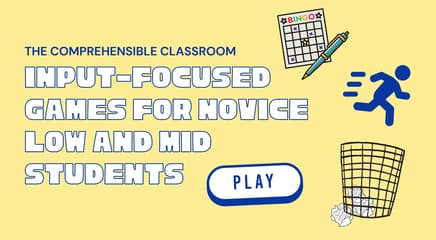Running Dictation is a favorite activity among world language teachers, conceived by Jason Fritze and first taught to me by Michele Whaley. I first shared it on The Comprehensible Classroom blog here in 2011. In this high-energy game, students take turns with teammates to run to a poster, memorize a statement, and race back to dictate it to an awaiting teammate. This activity is always a hit... well... except when it isn't.
Inspired by Andrea Giganti Dima and Erin McGovern at a post-workshop team dinner, I bring you my first "Try this instead" blog post, with hopes but no promise of more such posts to come in the future ;-)
Running Dictation isn't always a fit
Even for activities that "everyone loves", there are always situations in which that activity will NOT be a smash hit. Remember that YOU are the expert in your classroom, and only you can determine whether an activity is a good fit for your classes.
Running Dictation may not work well if you have a class that is completely devoid of energy. If you try to run this activity when there is no energy in the room, it will be painful. There is probably a better way for you to accomplish the same goals with a different activity structure.
Running Dictation may also not work well if you have the opposite: too much energy or uncontrolled energy. This activity is intended to be FUN, but it will leave you with tears of frustration welling up in your eyes if it becomes chaotic.
However, as Andrea lamented, when you have multiple sections of the same class, not doing an activity in just ONE of your classes can be a total pain. Yet, it seems unfair to not allow ANY of her classes to experience the fun of Running Dictation just because it won't work with ONE of them. Andrea was looking for an alternative to Running Dictation that will keep all of her classes on the same schedule–doing about the same things–and that requires little or no additional prep.
What to do instead of Running Dictation?
For your classes that you know can handle Running Dictation, structure the activity as laid out in this blog post. For your other classes (those classes that I often refer to as "Plan B" classes"), try this instead: Sitting Transcription
Sitting Transcription
Let's walk through how to prep for and how to run a Sitting Transcription as a parallel, low-energy activity alternative to Running Dictation.
Teacher Prep: Sitting Transcription
For Running Dictation, I suggest preparing nine sentences and writing each one on a poster that is hung on the back wall of the classroom or in the hallway. Prepare for Sitting Transcription by taking the same nine sentences that you have written for your Running Dictation posters and popping them into a 3x3 grid on a slide, like this:
In this example, imagine that it is an English class that is reading the story of Beowulf. The events in the grid are written in English because the class is conducted in English. If this were for an Arabic class, the events would be written in Arabic. If it were a French class, the events would be written in French. If it were a German class.... you get the idea.
If you have planned more than nine events for your Running Dictation, stick with nine events for this grid. Leave off the first event and/or the last event, and you can add an extra task at the end of the activity sequence that requires students to fill it in.
Notice how each event is lettered. This is not necessary, but it will make it easy for you to check students' work!
Sitting Transcription Step 1: Draw a grid
In class, give a blank piece of paper to each student and have them divide it into a 3x3 grid. This could also be done on a device using an application like Google Slides, if you are a paperless classroom.
Sitting Transcription Step 2: Unscramble and transcribe
Project the slide that you prepared, and instruct students to transcribe, or copy, the nine events onto their grid. However, point out that the events are out of order. Students should first determine the correct order of the events, and then copy them in the correct order in their grid (top to bottom and left to right). Have them write the events at the top of each grid frame so that they have room to illustrate the story below the text.
A completed student grid for our example should look like this:
Sitting Transcription Step 3: Illustrate
Finally, have students illustrate their transcribed storyboards. Give them as much or as little time as needed to fit into your lesson plans and keep this class moving forward with your other classes.
Et voilà ! It's that simple! Not as fun, but just as effective. For your Plan B classes, Sitting Transcription could be just what you need.








